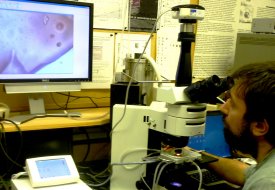Market leaders in temperature controlled microscopy, Linkam Scientific Instruments report the use of their 1400°C high temperature stage to study silicate melt inclusions in the Fluids Research Group of the Geosciences Department at Virginia Tech.
Researchers in the Fluids Research Group at Virginia Tech are concerned with the distribution, properties and role of fluids in and on the Earth, from its surface (shallow Earth's crust) to its deep interior (Earth's mantle). One of the research goals is to understand how volcanoes erupt. The volatile (H2O, CO2, SO2, etc.) content of a magma chamber beneath a volcano is of paramount importance because it determines the energy of the volcanic eruption. Magmas with high volatile contents tend to produce explosive, violent eruptions (like the eruption of Vesuvius that destroyed Pompeii), whereas magmas with lower volatile contents tend to produce more quiescent lava flows (like those in Hawaii). If the volatile content of the magma beneath a volcano can be predicted, then it is possible to predict the style of future eruptions and use this information in risk assessments.
 Rosario Esposito of the Bodnar Group at VTU using the Linkam high temperature stage to study silicate melt inclusions.
Rosario Esposito of the Bodnar Group at VTU using the Linkam high temperature stage to study silicate melt inclusions.
The only direct way to determine what the volatile content in the magma chamber was before an eruption is by measuring the volatile content in melt inclusions (MI). MI are droplets of melt entrapped during the growth of a crystal in a magma chamber. It is only possible to determine the volatile content of the MI if it remains as a homogeneous quenched melt (glass) as it cools following eruption from the magma chamber. Unfortunately, MI are often found partially or totally recrystallized. Thus, with some exceptions, one cannot analyze a MI to obtain a representative composition of the volatile content of the melt. However, a crystallized melt inclusion can be heated in a controllable temperature stage to re-melt the contents and then rapidly quench the MI to a homogenous glassy state. In this process, the volatiles are dissolved back into the melt and the quenched glass will have the same volatile abundance as it did at the moment of entrapment in the magma chamber.
Professor Bob Bodnar acquired the very first prototype Linkam high temperature X-Y stage for the Fluids Research Laboratory at Virginia Tech about 15 years ago and has pioneered its use in many papers in the intervening years. Used in conjunction with other techniques to homogenise samples, the current Linkam TS1400 X-Y stages provide a number of experimental advantages over other stages or test methods. The group also uses the Linkam THMS600 stages, one in conjunction with a HORIBA Scientific Raman spectrometer.
Speaking about his use of the Linkam TS1400 stages, PhD student Rosario Esposito says "I find it is much easier to mount and remove samples using the Linkam stage compared to other stages I have used. The Linkam stage is also furnished with an automatic heating/cooling rate controller whereas other temperature control systems have to be manually controlled. The Linkam TS1400 X-Y stage has excellent optics making it easier to observe the various phase changes in the melt inclusions during heating. The advent of the Linkam stage has led to many more high quality photographs appearing in the literature showing the behaviour of melt inclusions during heating."
The Linkam TS1400 X-Y stage has a ceramic tube heater which completely encases the sample in a uniform temperature controlled environment enabling high accuracy control up to 1400°C within a gas sealed chamber. Samples are mounted on a sapphire sample slide that can be moved up to 6mm in X and Y directions to better explore the sample. Fluid inclusion geologists (like the Bodnar Group) and material scientists interested in high speed quench cooling can add a special manipulator that enables rapid transfer from the heater to a much colder platform resulting in ultra-fast cooling rates of up to 240°C per second.